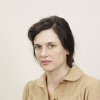Taryn Simon

Taryn Simon
Taryn Simonis a multidisciplinary artist who has worked in photography, text, sculpture and performance. Her practice involves extensive research, guided by an interest in systems of categorization and classification. Simon’s works have been the subject of monographic exhibitions at Ullens Center for Contemporary Art, Beijing; Museum of Modern Art, New York; Tate Modern, London; Neue Nationalgalerie, Berlin; and Whitney Museum of American Art, New York. Permanent collections include Metropolitan Museum of Art, Tate Modern, the Guggenheim Museum, Centre Georges Pompidou,...
NationalityAmerican
ProfessionArtist
CountryUnited States of America
Photography threatens fantasy.
There is no truth in photography. One can't reproduce an absolute truth. That said, I don't see [my photographs] as being any less truthful than any other photographs.
...photography's history is bound to the mistake, to the accident.
The photograph doesn't claim to be a participant, or to know, or to be a club member of whatever it's documenting - photography is more demanding when it doesn't pretend to know.
I'm designing a seductive frame to attract an audience to a subject they would otherwise ignore. And that's what I do in all of my photography - give a stage to things that wouldn't normally receive that stage.
Simulations directly relate to the process of and complications in photography. They also overtly create layers of fantasies, myths and interventions... The simulation confuses the idea of a truth. I've always been interested in this kind of theater and illusion at the foundation of belief.
Photography's ability to blur truth and fiction is one of its most compelling qualities. But when misused... this ambiguity can have severe, even lethal consequences.... Photography's ambiguity, beautiful in one context, can be devastating in another.
Documentary photography is becoming more illustrative as people become more familiar with photography’s limitations and vulnerabilities. Reality has always been interpreted through layers of manipulation, abstraction, and intervention. But now, it is very much on the surface. I like this honesty about its dishonesty. Every photograph has many truths and none. Photographs are ambiguous, no matter how seemingly scientific they appear to be. They are always subject to an uncontrollable context. This is a tired statement, but worth repeating.
I do seem to try to make things harder and harder for myself. In some perverse way, obstacles interest me and I'm drawn to projects that end up being incredibly laborious.
Archives exist because there's something that can't necessarily be articulated. Something is said in the gaps between all the information.
My work is drawn to the political but avoids an agenda. There is no inherent critique or support.
I'm interested in the murky areas where there are no clear answers - or sometimes multiple answers. It's here that I try to imagine patterns or codes to make sense of the unknowns that keep us up at night. I'm also interested in the invisible space between people in communication; the space guided by translation and misinterpretation.
The majority of my work is about preparation.
In my work, I construct texts and images. Between those two points the blur occurs. Each is altered by the other again and again, back and forth.